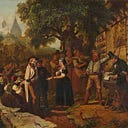Member-only story
BOOK REVIEW
Kurt Vonnegut’s Literal Crusade Against War: Slaughterhouse-Five
Even after many decades since it was published, the anti-war novel still keeps readers under its spell.

Slaughterhouse-Five, or, The Children’s Crusade: A Duty-Dance with Dance, a fictionalized account of the Allied bombing of the German city of Dresden in 1945, serves as a personal reckoning for novelist Kurt Vonnegut, who himself was an American POW held in captivity in a shelter in the city when the Allied planes brought an inferno upon innocent civilians. (Nearly 135,000 civilians were believed to be killed by the firebombs.) When captive prisoners emerged surface in the aftermath of the bombing to survey the wreckage and casualties in a city consumed by massive fires, Vonnegut becomes speechless. The scenes he saw forever haunted him for the rest of his life.
It later becomes an urge, when he returns to Chicago, to dwell on his experience in Dresden. “How to write about a tremendous event of war that he had been there for, and yet he had not been there for, because he was suspended underground?” notes Charles J. Shields, the author of the Vonnegut biography, And So It Goes.¹ And it takes more than 20 years for Vonnegut to finally craft something on Dresden: a novel suffused with humor and…
